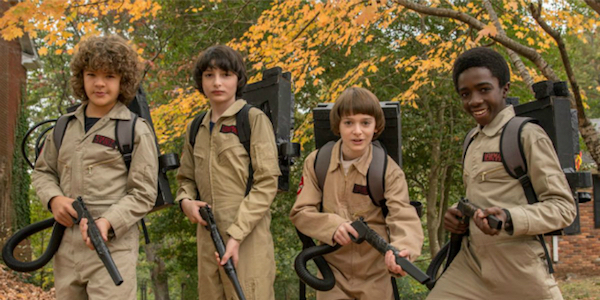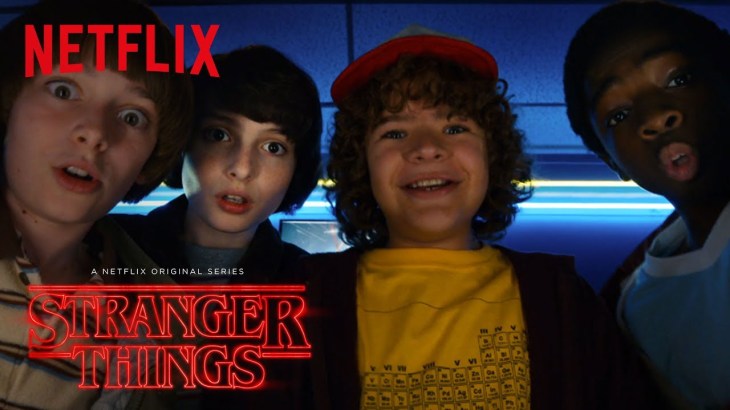In this essay, I'm going to be examining the use of intertextuality in this The Big Issue cover to see what meaning is being created, as well as make judgements and reach a conclusion about the advantages of this use of intertextuality.
Intertextuality is immediately introduced in the structure of this front cover; funky and old-school looking as it takes the appearance of Grange Hill, which is a Children's drama looking at life in a London comprehensive school, which would certainly appeal to the target audience, which would be the students and perhaps teachers. However, in this cover, the element of intertextuality is clearly introduced through other components, such as the different characters that we see in this front cover; Harry Potter, Ron Weasley and Hermione Granger. The reason why Harry Potter is introduced here is because as this Big Issue cover is about education, Harry Potter conforms to that, except it gives education positive connotations; magical, bright and optimistic, as in the Harry Potter series, Hogwarts is connoted as a school that every child would want to go to, as it's very flexible with the rules and its students, which is a complete contrast to normal schools today. Further, we can see other characters in this cover, such as Ozzy Osbourne who is a very known English vocalist, but is also known for having Dyslexia and not being understood back in school at the time, and I think that issues like that should be addressed, especially when it comes to education, because it shouts out a sort of awareness, and the fact that people with Dyslexia should be understood and helped, instead of being casted out, like Osbourne was. Moreover, in this cover, we can also see Pink Floyd's use of 'another brick in the wall' which essentially, is a song about how education creates clones and restricts complete freedom, and in some perspective, that is true. Some may argue that education does prevent freedom and self-expression. Next, in this cover, we have the main character, Offred, from the Handmaiden's Tale, being represented here, which could reflect the education system; the fact that it is extreme and it is in an authoritarian state, where people have no say, or in this case, students have to do what they're told, which again, is a statement that is true in most education systems. We also see other, not so prominent characters in this cover, such as Jean Brodie, where she believes education is more than curriculum, it's also personal, as Jean Brodie gives her students lessons about her personal love life and travels, promoting art history, classical studies, and fascism. Under her mentorship, these six girls whom Brodie singles out as the elite group among her students—known as the "Brodie set"—begin to stand out from the rest of the school. In addition to this, we can see Benedict Cumberbatch, who went to public school and had an art scholarship, he also displayed interest in rugby and painting, however, it was the theater/acting that captured his interest most of all, and said he didn't enjoy all of the experience, which could portray that students may lose interest in the things that they thought they wanted to study and find something else that they're interested in. Lastly, we can see the character Flashman being portrayed in the cover, who is a notorious bully at Rugby school and persecutor of Tom Brown, this again, represents a key issue in education; bullying, and that there needs to be a stop to it.
In conclusion, I think that there are many advantages, rather than disadvantages, in this cover, so for example, the main advantages is that, it's revealing the truth of what the education system is and what it SHOULD be; Harry Potter, the education system should be magical and fun to be around in, not the opposite, like Pink Floyd's 'another brick in the wall', where students get turned into 'clones' and where freedom is restricted, as well as self-expression. The fact these issues get addressed, is very positive because it'll help schools understand their pupils better and even get them help, which was the opposite of what Osbourne's school did, since he suffers from Dyslexia. In my opinion, mental disorders should definitely be more addressed in school and in general, because mental issues have been considered as a taboo subject for many years, and many people wouldn't talk about it and wouldn't explore the issues within, which again, shouldn't be the case because more and more people suffer from mental disorders everyday and nothing gets done about it. In terms of other advantages, Pink Floyd's 'another brick in the wall' is, in my opinion, a perfect representation of what some schools are like; turn the students into clones and robot-like objects, with freedom and self-expression restricted. Which again, is not how schools are supposed to be. Schools should be more enjoyable and more flexible with its rules and students, that way students can enjoy school life more. As for the character Offred, I think it's also an advantage of her being represented here, it reflects the authoritative and extreme society and education system we live in, where men are in power and women are inferior to them. However, the same could be said when applying to education; students have no say, they have to do what their teachers tell them to. In terms of Jean Brodie's view of schools having to be more personal instead of curriculum, I would say I fairly agree with her. It'd be quite interesting to have the two 50/50, where it's curriculum as well as personal, where students can get to know the teachers on a personal level as well as a professional level, and I think that would be an advantage because it would make students feel more comfortable in the space that they're in. In addition to this, with Benedict Cumberbatch, it's important to know what people themselves want to study so that they can have the best experience. Lastly, Flashman, a fictional book character, and a notorious bully, highlights one of the most important key issues in the education system; bullying. Bullying is not a very assessed key issue in most schools, which should change because bullying leads to a lot of mental health issues and again, nothing gets done about it. To summarise, I think it's an advantage that they've used these key characters to represent the education system, because it's a shout out to what needs to be done and what needs to be changed.










